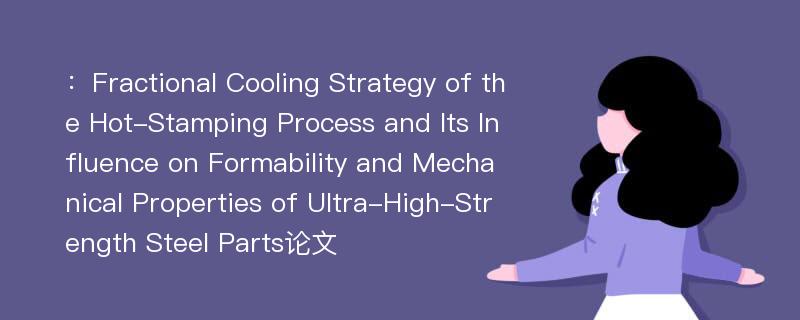
本文主要研究内容
作者(2019)在《Fractional Cooling Strategy of the Hot-Stamping Process and Its Influence on Formability and Mechanical Properties of Ultra-High-Strength Steel Parts》一文中研究指出:The effects of forming temperature on the formability and product properties of hot-stamping boron steel B1500HS were investigated. Based on the fractional cooling strategy, boron steel sheets were heated to achieve full austenitization before they were removed from the furnace and cooled to the forming temperature using different cooling methods. Subsequently,they were simultaneously press-formed and quenched inside the tool until the martensitic transformation was finished. A series of thermal tensile tests were conducted to study the effects of forming temperatures on the stamping performance indices, including elongation, yield ratio, and hardening exponent. Then, the mechanical properties and microstructures of the hot-stamped products were characterized. Finally, an irregular part was formed using different fractional cooling strategies, while its formability and springback phenomena were discussed. The results show that using a fast-cooling method to reach 650 °C as the forming temperature optimizes the formability of the tested B1500HS boron steel. The best mechanical properties and smallest springback values were achieved using this optimal strategy.
Abstract
The effects of forming temperature on the formability and product properties of hot-stamping boron steel B1500HS were investigated. Based on the fractional cooling strategy, boron steel sheets were heated to achieve full austenitization before they were removed from the furnace and cooled to the forming temperature using different cooling methods. Subsequently,they were simultaneously press-formed and quenched inside the tool until the martensitic transformation was finished. A series of thermal tensile tests were conducted to study the effects of forming temperatures on the stamping performance indices, including elongation, yield ratio, and hardening exponent. Then, the mechanical properties and microstructures of the hot-stamped products were characterized. Finally, an irregular part was formed using different fractional cooling strategies, while its formability and springback phenomena were discussed. The results show that using a fast-cooling method to reach 650 °C as the forming temperature optimizes the formability of the tested B1500HS boron steel. The best mechanical properties and smallest springback values were achieved using this optimal strategy.
论文参考文献
[1].Effects of strontium and boron interactions in Al-7Si alloys[J]. Chen Xiang and Li Yanxiang (Key Laboratory for Advanced Materials Processing Technology, Ministry of Education, Department of Mechanical Engineering, Tsinghua University, Beijing 100084, China). China Foundry.2010(04)[2].Effect of boron on hot strips of low carbon steel produced by compact strip production[J]. Hao Yu and Yonglin Kang School of Materials Science and Engineering, University of Science and Technology Beijing, Beijing 100083, China. Journal of University of Science and Technology Beijing.2008(02)[3].Influence of boron on mechanical properties of M951 alloy[J]. 周鹏杰,于金江,孙晓峰,管恒荣,胡壮麒. Transactions of Nonferrous Metals Society of China.2005(S3)[4].Surface diffusivity of atomic deuterium on Ni3(Al, Ti)(110) surface with and without boron[J]. J.L. Wang, Y.W. Chung (Department of Materials Science and Engineering, Robert R. McCormick School of Engineering and Applied Science, Northwestern University, Evanston, IL 60208, USA). Transactions of Nonferrous Metals Society of China.2002(04)[5].Reaction of boron to transition metal impurities and its effect on conductivity of aluminum[J]. 王桂芹,刘顺华,李长茂,高钦. Transactions of Nonferrous Metals Society of China.2002(06)[6].EFFECT OF SILICON ON PRODUCING DUCTILE IRON WITH COMPLEX STRUCTURE OF BAINITE AND MARTENSITE[J]. Y.P.Zhang,J.X.Zhu,Y.Q.Wang,J.Y.Su. Acta Metallurgica Sinica(English Letters).1998(01)[7].Beryllium Surface Modified by B Ion Implantation[J]. 胡仁元,杨玉石. Journal of Materials Science & Technology.1989(03)[8].INFLUENCE OF BORON ON MICROSTRUCTURE AND MECHANICAL PROPERTIES OF RAPIDLY SOLIDIFIED Ni3Al[J]. LI Hui Institute of Metal Research,Academia Sinica,Shenyang,ChinaLIU Xiang Northeast Institute of Technology,Shenyang,ChinaGUO Jianting HU Zhuangqi Institute of Metal Research,Academia Sinica,Shenyang,China Associate Professor,Institute of Metall Research,Academia Sinica,Shenyang,China. Acta Metallurgica Sinica(English Edition).1989(04)[9].Determination of Shallow Impurity Concentration in Detector-grade Silicon by FT-IR Spectroscopy at 4.2K[J]. Zhang Jichang Pohl lnstitute for Solid State Physics,Physics Dept.,Tongji University,Shanghai,China.Wu Jiangen Qu Fengyuan Laboratory for Semiconductor Physics,Physics Dept.,Fudan University,Shanghai,China.Ye Hongjuan Xiao Jincai Yu Zhiyi Lu Wei Laboratory for Infrared Physics,Shanghai Institute of Technical Physics,Academia Siniea.. Rare Metals.1989(04)[10].INFLUENCE OF B ON H2S CORROSION-RESISTANTBEHAVIOR OF Fe-BASED AMORPHOUS[J]. HU Hanqi;YANG Zhongshou, University of Science and Technology Beijing, Beijing, China. Acta Metallurgica Sinica(English Edition).1989(11)
论文详细介绍
论文作者分别是来自Acta Metallurgica Sinica(English Letters)的,发表于刊物Acta Metallurgica Sinica(English Letters)2019年03期论文,是一篇关于,Acta Metallurgica Sinica(English Letters)2019年03期论文的文章。本文可供学术参考使用,各位学者可以免费参考阅读下载,文章观点不代表本站观点,资料来自Acta Metallurgica Sinica(English Letters)2019年03期论文网站,若本站收录的文献无意侵犯了您的著作版权,请联系我们删除。
标签:Acta Metallurgica Sinica(English Letters)2019年03期论文;
:Fractional Cooling Strategy of the Hot-Stamping Process and Its Influence on Formability and Mechanical Properties of Ultra-High-Strength Steel Parts论文
下载Doc文档
